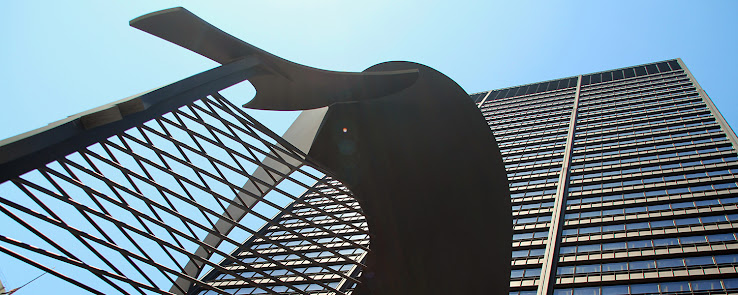

Bulldog and Hydrant, by Marshall Svendsen..

Marshall Svendsen..
Casting a metal sculpture is a long process, very physically demanding and also a very lonely process and has to be very carefully conducted. There 's a lot of scope for mishaps. If done with care and attention, the final sculpture will last for centuries to come.. Hats off to all the sculptors out there!!!
My Special Thanks goes to Marshall Svendsen, for giving me this privilege of photographing and documenting the process. There were some long phone calls on understanding the stages. I think, I finally get it!!!

Click on the above image to enlarge..
The bronze sculpture "Bulldog and Hydrant" went through many different stages. The "Lost Wax method" of bronze casting was used. The many different steps in the making of this sculpture is explained below.. The above image is a visual guide to the process in a nutshell.. Click on the image to enlarge and and see the stages..
Stage I: Sketch Stage..
Stage II: Maquette Stage..
Stage III: Foam Model..
Stage IV: Rubber & Plaster Mold..
Stage V: Wax Mold..
Stage VI: Ceramic Mold [destroyed in the making of the sculpture]..
Stage VII: Final bronze cast sculpture, which had to be welded, chased, textured and patinaed..
THE LOST WAX METHOD OF CASTING A BRONZE SCULPTURE..

THE ORIGINAL SKETCH..
Bulldog and Hydrant is a commissioned work.. Marshall was approached with a very clear guideline of what was to be made, an English Bulldog urinating on a fire hydrant.. This was the original sketch he produced, which was approved..

MAQUETTE ..
When this small-scale model was approved, it was time for the first full scale model of the sculpture..

THE LOST WAX METHOD OF CASTING A BRONZE SCULPTURE..
FOAM MODEL / POSITIVE MODEL..
A bronze sculpture is made in many stages.. Here is the original model made from foam. The original model can be made of clay, wood or any other material..

RUBBER MOLD / NEGATIVE MOLD..
The original model is coated with rubber. When the rubber dries, a protective reinforced plaster is built around the pliable rubber, to support it. This protective plaster mold is called the "Mother Mold".. The mold is done in several sections. Like the torso, legs and head have seperate molds..

WAX MODEL / POSITIVE MODEL..
Molten wax [210 degree F] is poured into the rubber mold. The hot wax is rolled or slushed around, for the wax to settle evenly. The process is repeated a few times to get the desired thickness. The wax model is a very important stage. Attention is given to all the details. Any flaw at this stage will show later in the bronze sculpture..
For more, click here..
SPRUCING THE WAX MODEL..
A network of wax rods or sprues are attached to the wax model, that create gates and vents for the molten bronze to flow and air to escape. The sprucing system usually begins at the top with a wax cup, which is attached by wax rods to various parts of the wax model.
INVESTING / CERAMIC SHELL..
The spruced wax is dipped into vats of slurry and then dried on sand. This makes a ceramic shell around the wax model. The shell is allowed to dry. This process is repeated a few time for desired thickness [about 1/2 inch]. Thus a thin coat of ceramic shell is built around the wax mold.
HOLLOW CERAMIC SHELL/ BURNT OUT/ LOST WAX/ NEGATIVE MOLD..
The ceramic shell coated wax model is placed cup-down in a kiln. The heat hardens the silica shell and the wax melts and runs out. Thus the name "Lost Wax Method". The melted wax can be recovered and reused. Now what remains is a negative space inside a ceramic shell, formerly occupied by wax. This empty hollow space will later be filled with molten bronze.

BRONZE POUR / METAL POUR
The shell is reheated in a kiln, with cup-upwards. Molten bronze [1950 - 2150 degree F] is poured into the cup. Then it is allowed to cool down..
RELEASE..
When the shell cools off, it is carefully chiselled out, using basic tools like hammer, uncovering the bronze casting. The sprues are cut-off. The pieces can be sand blasted..

METAL WELDING..
The bronze cast pieces are welded together.. Finally a complete sculpture comes to shape..

METAL CHASING..
Then the traces of welding has to removed by blending and texturing..The telltale signs of casting process are removed, like the attachment points of spruces are blended, any marks of air bubbles are smoothed, the welding marks are blended.. and the sculpture is given the desired texture..
For more, click here..

PATINA..
Patina is the surface color of bronze. It can be natural or man-made. Here we are talking about the man-made patina, as a result of reaction of copper with chemicals.. These chemicals were sprayed on the sculptural piece and then the piece was torch-heated, for the chemical reaction to expedite.. The process was repeated over and over again..to get the desired result..
For more, click here..

"Bulldog and Hydrant" by Marshall Svendsen, is finally complete, ready to be installed..

It reads..
Bulldog and Hydrant
Cast bronze, 2010
Svendsen, Marshall
American Sculptor, b 1980
Dedicated to Ruth Helen Wolf, and,
her long-time counselor and friend Harry C. Benford, III..

Feels like I have done a commercial for True Form Productions..

In the photo, Marshall Svendsen is to the right and his brother Jarrett Svendsen is to the left..
Related links..
# Making of "Bulldog and Hydrant" [Part-I] ..
# Making of "Bulldog and Hydrant" [Part-II]..
# Making of "Bulldog and Hydrant" [Part-III]..
# Making of "Bulldog and Hydrant" [Part-IV]..
# Metal Pour at True Form Production..

AMAZING DOCUMENTATION.
ReplyDeleteThis is like a public service to the sculptor community and to the people of Chicago.
You Rock!
ReplyDeleteA long time follower of your blog.
- Mike.